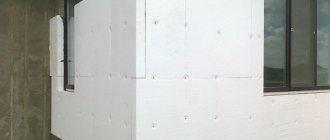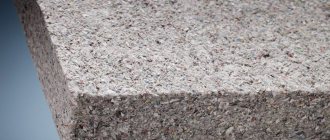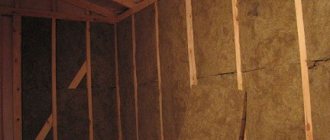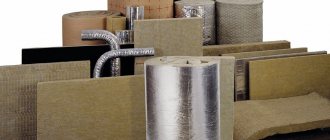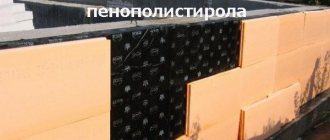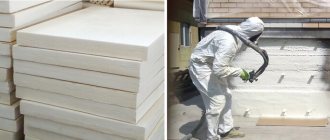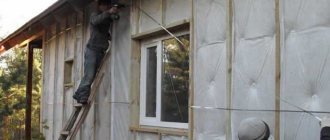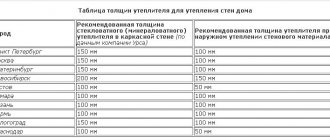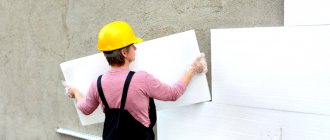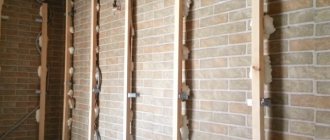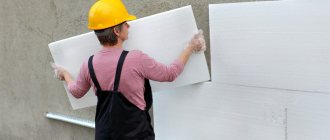Insulating the facade with extruded polystyrene foam is one of the modern ways to increase the energy efficiency of a home, improve the microclimate in it and, as a result, save costs on resource consumption. This kind of insulation is available on the market, including domestic brands that are popular among consumers (for example, “Penoplex” and “Technoplex”).
Insulating the facade with polystyrene foam is a modern way to increase the energy efficiency of a home
Criteria for choosing expanded polystyrene
The main characteristic when choosing insulating building materials for the facade of a house and roof is the density of polystyrene foam, its numerical expression is indicated in the brand. PSB-15 has the minimum indicator, and PSB-S-15, PSB-S-25, PSB-S-35 are recommended for outdoor work.
Figure 1. Facade insulation with polystyrene foam
The choice of thickness of expanded polystyrene slabs is focused on the climatic features of the region where the building is located. It should be noted that a 3 cm sheet of PSB-15 in terms of thermal conductivity is similar to 40 cm of brickwork, 25 cm of gas or foam concrete or 10 cm of wood. In addition, the foam plastic is necessarily covered with a layer of plaster, which also acts as insulation for the facade walls.
Preparing the wall for finishing
Finishing begins after reinforcement of the insulation.
Finishing of the facade can begin only after reinforcement of the insulation. The mesh attached to it will prevent cracking of the decorative coating. In addition, it will make the structure more monolithic. Material with a surface density of 150 g/m² is glued to the wall.
- To reinforce the slopes, you can use a less strong mesh. It is applied to the wall after applying the adhesive. The mesh strips are fixed with an overlap. The width of the material strip should exceed the width of the surface treated with glue by 8–10 cm, which will avoid the appearance of unevenness when gluing adjacent edges.
- The mesh is pressed into the glue with a rubber spatula. It is smoothed from the center to the edges. Then the adhesive composition is applied to the next section of the facade, including the strip under the edge of the fixed material, etc. After reinforcement is completed, the dried surface is rubbed with sandpaper.
- The wall is once again leveled with putty mixture. After it hardens and grouts, a primer is applied with an abrasive tool. The final finishing of the facade is completed by plastering or painting.
Preparatory work
Before insulation of the external walls of the house begins, it is necessary to prepare the working surface.
Preparation of external walls
The surface to which the insulation will be attached must be smooth and clean. All differences when preparing the walls of the house must be removed, because this can cause fractures of the polystyrene foam during its installation. Fluctuations in uniformity should not exceed 1-2 cm, and large tubercles can be knocked down with a hammer, after which all peelings can be carefully removed. Also, if paint or whitewash was previously applied, it must be removed and dust and dirt removed.
Figure 2. Wall preparation process
To prime or not
After leveling, the surface of the wall should be treated with a soil mixture, because in this way small particles are removed and maximum adhesion and protection against the spread of microorganisms and fungi is ensured.
You can avoid priming the walls; running your palm over them does not leave any dirt behind. The choice is yours, but this inexpensive process improves the quality of facade insulation with polystyrene foam.
Any priming mixture can be used for exterior use according to the instructions on the package. Apply by brush, roller or spray.
Preparation of EPPS
In fact, foam boards are already ready to go, but if you have chosen extruded polystyrene foam, then you should pay special attention to it. A very smooth surface does not adhere well to glue, so it is necessary to make it looser before installing the slabs. This procedure is carried out with a needle roller for working with drywall; if such a tool is not in your arsenal, then it can be done using a mounting knife, which you need to make grooves. If you plan to apply the insulation in two layers, then treat both sides.
Finishing window sills and slopes
The structures of window sills, slopes and “drip” should be installed before the walls are insulated. Particular attention should be paid to the following points:
- The window sill should have a protrusion of 30-40 mm from the finish, so 10-11 cm must be added to the width, because the width of the polystyrene foam, as well as the finish, is taken into account.
- When finishing slopes, insulation with a smaller thickness is used - 2-3 cm is enough to prevent the wall from moving onto the glass. When performing installation, the foam board should protrude 10 mm beyond the facade wall for easy joining.
- Between the base and the insulation, it is necessary to install a so-called “drip line” made of galvanized steel, so that natural precipitation does not accumulate on the walls, but flows off.
Figure 3. Finishing near the windows
Thus, you see that the preparatory work stage requires special attention and a lot of time and effort, however, the service life and effectiveness of polystyrene insulation will depend on the quality of their implementation, so you should not neglect this.
Insulation materials
0 votes
+
Vote for!
—
Vote against!
The feasibility of thermal insulation of walls is obvious to many owners of apartments and private houses. Currently, polystyrene foam is used as the most effective insulation. Thanks to such thermal insulation, you can significantly reduce space heating costs. In addition, the insulation is quite light in weight, which greatly simplifies the installation procedure. The article will discuss how to insulate the facade of a house with polystyrene foam.
Advantages of insulating facades with extruded polystyrene foam
Facade insulation of a home has a number of advantages.
- Insulation of the external surface of the walls guarantees the location of the dew point outside the load-bearing wall. This is guaranteed to eliminate situations of wall freezing and moisture accumulation.
- Due to thermal inertia, the insulated facade of the building will act as a temperature stabilizer. Nighttime temperature drops will not affect indoor climate changes.
- External insulation, unlike internal insulation, does not affect the change in the area of the rooms.
Characteristics of expanded polystyrene
The unique manufacturing technology of façade polystyrene foam contributes to the high strength and durability of the material, in comparison with other types of insulation.
Manufacturing process:
- polymer granules are combined with a foaming catalyst;
- Subsequently, the finished mass is subjected to heat treatment using an active substance - an extruder. Its main task is the uniform distribution of components and the formation of a homogeneous substance;
- slabs of various sizes and thicknesses are formed from the finished composition, after which they undergo a cooling procedure;
- The result is high-quality thermal insulation.
Advantages of expanded polystyrene:
- high strength;
- waterproofing properties;
- low level of fire hazard (does not ignite, but with prolonged exposure to high temperatures or fire it begins to melt)
- chemical resistance;
- environmental friendliness;
- correspondence: price - quality.
Myths about polystyrene foam
The market for thermal insulation materials is represented by a wide selection of insulation materials of various shapes, sizes and structures. Expanded polystyrene appeared relatively recently, but has already acquired myths and misconceptions regarding its quality.
- To insulate the facade, it is preferable to choose extruded polystyrene foam instead of regular foam . The only difference between these two materials is the different production technology. In the manufacture of foam insulation, a higher temperature and pressing method are used. The difference in thermal conductivity is 0.002 units. When choosing one of the materials, it is worth considering that extruded polystyrene foam is capable of deformation when exposed to ultra-high temperatures. In addition, its fastening, unlike other materials, is carried out using special glue.
- Walls covered with polystyrene foam lack air exchange . This is true. The insulation comprehensively protects the building from the entry of both warm and cold air. This is its purpose. And for air conditioning indoors, it is necessary to use ventilation systems.
- Expanded polystyrene is a highly flammable material . This is not entirely true. The material can indeed be damaged by fire, since it contains certain chemical components. However, proper installation and compliance with all its technical features completely prevent the material from igniting. To avoid fire, polystyrene foam cannot be used to insulate chimneys, fireplaces, or to sheathe the walls of bathhouses and boiler rooms. The combustion temperature of the insulation is +490 C0. This value is twice as high as the burning of wood and paper.
- Expanded polystyrene is not durable . This is not entirely reliable information. Expanded polystyrene boards can withstand cyclic testing for an average of 80 years. But, the material can be affected by mechanical stress and ultraviolet radiation. However, being under decorative finishing, the insulation has a sufficient margin of durability.
- Expanded polystyrene is a material hazardous to health and the environment. The harm of polystyrene foam has not yet been proven. In addition, it is constantly used as a material for creating food packaging. The composition of expanded polystyrene does not contain toxic substances, and its chemical formula is not capable of harming human health. As for the environment, this material must be disposed of in a special way, and not thrown away in places where public waste accumulates.
- After installing the reinforcing mesh, you can immediately begin painting . This is not true; the walls must be puttied or plastered over the reinforcing base. This is not done to create a beautiful texture, but to protect the thermal insulation layer from mechanical damage, and the reinforcing layer from moisture.
Comparison of polystyrene foam with other thermal insulation
In order to make sure of the need to purchase expanded polystyrene as a material for insulating the facade of a house, it is worth considering its distinctive characteristics with other insulation materials.
- Mineral wool. Mineral wool has been considered an equally popular material for insulation in recent years. Thermal insulation is a material based on fibers, which are obtained by melting rocks and slags. The main advantages, unlike all other materials, are high fire resistance qualities. As for the disadvantages, the most noticeable is hygroscopicity. The insulation is capable of absorbing all the surrounding moisture, which negatively affects the walls of the building. This factor also complicates its preservation before work on insulating the house begins. As for heat capacity, both insulation materials: expanded polystyrene and mineral wool show the same results.
- Basalt wool. The insulation is made from basalt rocks during the melting process until a fibrous structure is obtained. In addition, unlike its mineral counterpart, it has water-repellent properties. It does not deform during operation and is suitable for both internal and external insulation.
- Penofol . The material is presented in the form of foamed polyethylene, covered on one side with a layer of foil. It is used for both thermal insulation and waterproofing. Does not contain substances hazardous to the environment. Unlike expanded polystyrene, it is more suitable for interior work.
Expanded polystyrene is considered a universal material for thermal insulation; its properties in some cases are similar to other insulation materials. But there are also certain advantages: moisture resistance, ease of installation and excellent thermal insulation properties.
Choosing polystyrene foam for the facade
- The specifics of insulating facade walls involve the use of densely structured polystyrene foam grade C-25. This density was not chosen by chance, since the higher its indicators, the better the thermal insulation properties.
- A material with a density of 15 kg/m3 will no longer be able to provide the necessary structure for insulating the facade of a building. In addition, there is a possibility of damage to the material during finishing and further operation of the house.
Today, the decor of external walls with facade elements made of polystyrene foam is gaining popularity. At a low cost, this is an easy way to transform the appearance of your home.
Insulation of the house facade with polystyrene foam
Materials and tools for work
In the process of insulating the facade of a house with polystyrene foam, you will need the following tools:
- drill;
- construction knife;
- hammer;
- spatulas of different lengths;
- plumb and level.
In addition, you should prepare the following materials:
- expanded polystyrene sheets (density - 25 kg/m3, thickness of main sheets - 5 cm, thickness of sheets for slopes - 3 cm);
- fasteners: wide-head dowels, plastic nails;
- glue;
- polyurethane foam;
- reinforced mesh;
- decorative finishing
- primer;
- base profile.
Preparatory work before insulating the facade with polystyrene foam
Before insulating the facade with expanded polystyrene, it is worth carrying out careful preparation.
- Dismantle from the surface of the walls: storm drains, ebb tides, ventilation grilles, climate control structures, lighting fixtures, decorative elements. Removal of previous finishing: tiles, remaining plaster, paint.
- Next, you should check the evenness of the surface and its deviation along the vertical line. Installing expanded polystyrene does not require the formation of a perfectly flat wall surface. However, significant differences should be leveled out using plaster, since moisture can accumulate in the recesses, which will negatively affect the insulation layer.
- If the surface of the wall is covered with a loose finish, it must be strengthened with a primer. And after drying, apply a layer of plaster.
- The insulating material does not require additional preparation, only if the work does not use an extruded type of polystyrene foam - penoplex. This insulation has a smooth surface, which must be made more porous before installation. To do this, one side of the foam sheet must be pierced with a needle roller. If you don’t have this in your arsenal, you can use a construction knife to create shallow notches.
Insulation of slopes and installation of flashings
- The next stage in carrying out façade insulation work is to install ebb and flows and carry out thermal insulation of the slopes. The length of the ebb should fully correspond to the thickness of the layer consisting of polystyrene foam, plaster and an additional play of several centimeters.
- Window slopes also need to be insulated. For this, polystyrene foam with a thickness of at least 2 cm is used. It is worth considering that the insulation should protrude 1 cm from the material with which the walls are covered. Such a reserve will allow for a better connection of the insulation attached to the slopes with the one that covers the walls.
Installation of polystyrene foam on the facade
Gluing expanded polystyrene to the wall surface is carried out using mounting adhesive. Additionally, the material is secured using wide-headed dowels.
Stages of work
- You need to install a starting profile in the lower space of the wall. In the future, it will hold the polystyrene foam on the glue and deprive it of mobility.
- Next, you should apply the adhesive composition to the entire perimeter of the wall and additionally, using a point method, throw a large amount of the composition onto the edges and middle of the polystyrene foam sheet. At this stage, you can use glue to correct minor unevenness in the wall surface.
- The sheets are pressed tightly against the wall one after another. The material can only be glued horizontally. The period of adhesion of polystyrene foam to the walls takes about three days.
Facade insulation with polystyrene foam technology
- The next step is to secure the polystyrene sheets with dowels. The length of the fastening must be calculated taking into account the entry into the wall of the building by at least 5 cm. They must be located at the joining points and in the central part of the sheet. For this, holes with a diameter of 1 cm are prepared. In this case, the depth should be higher than the length of the mounting dowels. After installing the dowel in the groove, you need to hammer a plastic nail into it.
Tip: plastic was not chosen by chance as the material for fastening, since it does not conduct low temperatures, unlike metal.
- The distance between sheets of polystyrene foam exceeding the width of 0.5 cm must be filled with foam. If the difference exceeds 2 cm, then it must be covered with strips of insulation and then thoroughly foamed. After five hours, the foam completely hardens, and its excess is removed with a construction knife. Visible unevenness should be leveled with a float designed for polystyrene foam.
Advice: when performing insulation in two layers, it is necessary to make fasteners with crossing seams: longitudinal and transverse. In this way, foaming of the seams of the lower layer can be avoided.
- The nail heads must be cleaned and puttied. Any unevenness in the putty should be sanded with medium-grain sandpaper.
Fastening the reinforcing mesh
The facade of buildings is evenly covered with reinforcing mesh, which is pre-attached to perforated corners. A mesh with a density of 150 g/m2 is suitable for outdoor work. The evenness of the finished surface will directly depend on the density indicator. You need to glue the mesh using mounting adhesive.
Attaching the mesh to slopes and wall corners:
- to decorate the corners of walls and slopes, strips of 30 cm should be cut from the mesh. When preparing the material for decorating the slopes, you should also take into account the height of the opening;
- then the strip is bent in half;
- it is necessary to apply the mounting mixture to the corner of the building using a wide spatula;
- the mesh is pressed tightly against the corner or slope and smoothed using a rubberized spatula.
Installation of mesh on the facade:
- the walls are covered with a net of small canvases;
- the mounting mixture is applied 0.3 cm thick;
- the material is applied in such a way that 10 cm of its surface lies on the polystyrene foam not covered with the solution;
- Next, you should smooth out the reinforcing surface using a rubberized spatula, making movements from the center to the edges;
- if necessary, you can add a mounting solution to uniformly cover the construction mesh;
- a solution is applied to the uncovered areas of the material and the next strip is laid overlapping;
- After complete hardening, grouting is carried out with fine-grain sandpaper.
Preparing for finishing
- Before the final finishing of the building facade, after the insulation procedure using polystyrene foam, it is necessary to carry out a number of preparatory work.
- The first step is to apply a leveling layer. It is applied using a large spatula (35 cm). This layer is sanded with fine-grained sandpaper.
- The next step will be priming the facade (except when a decorative coating in the form of tiles or bricks is used).
- The work is completed with a fine finishing: decorative paint or plaster.
Compliance with technological standards for working with expanded polystyrene
All stages of the process of insulating the facade of a building using polystyrene foam boards require compliance with the technological aspects of the work:
- temperature readings should not be higher than 25 degrees Celsius;
- humidity should not exceed 80%;
- During all stages, it is necessary to carefully protect the façade of the building from exposure to sunlight and precipitation.
Insulation of facade with polystyrene foam video
Common mistakes when finishing facades with polystyrene foam
Insulating the façade of a building with expanded polystyrene slabs has become the most common method of insulation. This is not at all surprising, since installation of the slabs is quite simple and takes a relatively short period of time. In addition, the insulation process does not require special knowledge or the use of professional equipment. But, as a rule, during the first experience of working with polystyrene foam, certain mistakes and shortcomings are made, which will have unpleasant consequences in further operation. What you should pay attention to during the thermal insulation process.
- High-quality installation of the plinth rail . As a rule, only the ends are fixed. The result of such actions is its deformation under the influence of high temperature, after which the strip bends and contributes to the appearance of cracks in the facade finish. To avoid such problems, it is necessary to cut the bottom of the polystyrene foam in such a way as to match the material with the plinth rail and create an additional attachment point. On top of the cut area, 10 cm of finishing should be knocked down, thermal insulation and construction mesh should be glued. Finishing can be applied over the prepared base.
- When using a guide rail, do not bend the mesh under it. It must be trimmed along the bottom edge of the rail. This is due to the fact that the adhesion of metal and plaster is relatively low. Otherwise, the plaster may quickly fall off the wall.
- In the absence of a base rail, the polystyrene foam slabs will be in direct contact with the ground . The result of this interaction will be the material getting wet, which will lead to a deterioration in its properties. When attaching thermal insulation in the basement area, the best option would be to use extruded polystyrene foam. It has greater density, repels moisture and has low heat conductivity parameters. In such a case, the construction mesh should be wrapped directly under the thermal insulation sheets.
- Expanded polystyrene can only be fixed to a flat base . If the plaster has free-flowing properties, it must first be knocked down or strengthened with a primer. The same rule applies to damp walls. Before insulation, they must be dried and the cause of the wetness must be eliminated.
A DIY polystyrene foam facade will take a little time, but in return you can get warm rooms and significant savings when paying for heating services. By following all stages of installation and taking into account the most common mistakes when working with insulation, you can insulate your house yourself without involving professionals.
Characteristics of expanded polystyrene
Expanded polystyrene will protect the facade of the house from moisture and temperature. Thermal conductivity of 0.038 W/mK allows for insulation using only one layer of polystyrene foam. The material has a high hydrophobicity index. Expanded polystyrene practically does not absorb water. Polystyrene foam will completely rid the walls of moisture. Refers to slightly flammable materials. But installation must be carried out following fire safety instructions.
Characteristics of expanded polystyrene in comparison with other materials
Fire hazard
There are many misconceptions about the quality and characteristics of insulation. The material is considered to be highly flammable. But if the installation is carried out, taking into account the characteristics and properties of polystyrene foam, then ignition will be excluded. For this purpose, protective coatings from other building materials are used. The combustion temperature of polystyrene foam boards becomes 491 degrees. The indicator is 2 times higher than that of paper and wood.
The flammability of expanded polystyrene is lower than that of polystyrene foam
Durability
Many people are also concerned about the durability of the insulation. But under finishing, without external mechanical damage, the material does not deteriorate at all.
Environmental friendliness
Synthetic materials can be harmful to health. But polystyrene foam is absolutely safe. There are no toxic substances in it. Remaining or replaced material must be disposed of for further processing. Throwing it into ordinary trash cans is strictly prohibited.
Features of the material in comparison with other types of insulation
The main feature of extruded polystyrene foam can be called its production technology. It differs significantly from the manufacture of conventional polystyrene foam, which is why it has a number of significant differences that prevail over its predecessor:
- The structure of the material consists of a solid mass of cells filled with gas molecules, therefore the density and strength of the panels is much higher than that of polystyrene foam;
- Due to its molecular structure, finishing with extruded polystyrene foam allows you to retain heat inside the building much longer - its service life is longer;
- Excellent frost resistance, low coefficient of vapor permeability and thermal conductivity increase its service life outside the house;
- Compared to mineral or glass wool, facade insulation can be done without protective clothing. The material does not pose any harm to humans.
Thanks to this video, you can learn how to distinguish high-quality material from counterfeit.
Analytical comparison table of conventional polystyrene foam with extruded polystyrene foam:
| Comparison criteria | Extruded polystyrene foam | Styrofoam |
| Moisture absorption, 30 days, m3 | 0,4 | 4 |
| Moisture absorption per day, m3 | 0,2 | 2 |
| Vapor permeability, mg/m, h, Pa | 0,02 | — |
| Thermal conductivity, W/ (m*K) | 0,03-0,035 | 0,035-0,45 |
| Bending strength, kg/cm | 0,5-0,9 | 0,08-2 |
| Compressive strength at 10% deformation, N/mm2 | 0,26-0,6 | 0,06-0,3 |
| Sheet density, kg/m3 | 29-46 | 15-30 |
| Operating temperature range, C | -45..+70 | -50..+70 |
Other benefits
- Insulating the wall allows you to move the dew point outside the facade. Thus, freezing of facades and the formation of mold in this case are excluded;
- A building finished with extruded polystyrene foam can be called a thermal stabilizer. In other words, temperature changes during the day and evening are not scary for him. The indoor climate will remain the same;
- Thermal insulation of the wall from the outside does not take up space inside the building.
How to insulate a house with polystyrene foam?
To do everything correctly and efficiently, you should adhere to a certain technology for installing and decorating insulation. It may be difficult for a beginner to cope with a large number of stages and processes, but if you wish, you can do everything yourself.
If you don’t have the energy and time, hire a professional team of workers. This will entail additional costs, but you will definitely save your time.
Materials and tools required for work
You don’t have to buy expensive equipment to process and install EPP boards. It is enough to use the tools that you already have on the farm or you can borrow from people you know. An approximate list of what you will need:
- EPP plates of the required thickness;
- tape measure and pencil for marking;
- building level;
- stationery knife;
- drill or hammer drill for making holes for dowels;
- umbrella dowels;
- specialized adhesive solution;
- facing material.
Technical characteristics and fire resistance
Manufacturers of extruded polystyrene foam provide the buyer with a large list of positive characteristics and properties that distinguish the material from its relatives. But in fact, they also hide many nuances.
Let's look at environmental safety. Since EPP can serve for a long time without changing its technical parameters, it would seem that the material is absolutely safe. But it is not so. Each insulation has a certain period of time, after which the material begins to “age”.
As a result, caustic vapors and substances are released into the environment. The same substances are released when extruded polystyrene foam is heated to 80 degrees Celsius and above.
Now fire safety. Manufacturers claim that the material extinguishes immediately after the fire stops. And this has actually been confirmed in laboratory conditions, where there are no other finishing materials or elements of the main structure. But in practice everything is completely different.
There are other materials around extruded polystyrene foam that, if they do not support combustion, can heat up to high temperatures, which will cause the insulation to catch fire. In addition, it is impossible to immediately stop the access of fire.
Small pockets may remain under the casing, which will swell again and again with air currents. And the amount of smoke that is generated during the smoldering process of EPP cannot be compared even with burning rubber.
In some cases, manufacturers embellish the reality, and in others they draw conclusions solely on the basis of laboratory tests. Extruded polystyrene foam is a good insulator and has the right to exist in the modern world. But you don’t always have to rely on absolutely all characteristics.
Installation under siding
In order to perform insulation with polystyrene foam followed by finishing with siding, the installation of a sub-cladding system is required. It is constructed from a metal profile or wooden beam located vertically, with a pitch of no more than 40-60 cm. To fix the galvanized guides, brackets (suspensions) are used, which are attached to the wall with anchor elements or self-tapping screws.
The entire sheathing is leveled using a level, level, plumb line and fishing line. The type of material is selected depending on the panels used. Steel sheathing is ideal for metal siding. Its service life will be longer than wood.
It is important to know
Wooden beams must be treated with an antiseptic, and the use of a metal profile is allowed only if it is coated with zinc. To increase the service life, the profile can be painted using powder coating.
After the installation of the sheathing on the outside of the building is completed, insulation is carried out with polystyrene foam. If your choice fell on a wooden sheathing, then the slabs are installed between the guides, then fixed with the help of umbrella mushrooms. When using metal sheathing, the slabs are strung on brackets. Having completed fixing the panels to the walls, you can begin cladding with siding.
Thermal insulation of walls from the inside
Sometimes it is impossible to insulate a building from the outside. This situation may arise when the object being reconstructed has high cultural and historical significance, or the façade decoration of the building is distinguished by an abundance of unique decorative elements.
To insulate walls with extruded polystyrene foam from the inside, sheets of material of smaller thickness are used - from 10-20 to 30-40 mm, and they are laid in one layer. Laying is done directly on the inner surface of the walls using glue. Additional fixation of polystyrene foam sheets may not be necessary.
If there is no external insulation, then, as a rule, a small air gap is left between the insulation and the wall surface, which plays the role of ventilation. This protects the walls from condensation penetrating from the outside, which can cause excessive humidity and, as a result, rot. Thanks to the ventilation created, the wall has the opportunity to dry out.
In some cases, a ventilation gap is left between the insulation and the finishing material. As a result of such work, the thickness of the walls increases significantly, which entails a reduction in the internal space of the premises. Therefore, this method of thermal insulation is used when no other is suitable.
Finishing materials are attached to polystyrene foam using wooden lathing. As an option, you can fix plasterboard on sheets of extruded polystyrene foam, onto which the finishing is applied: panels, wallpaper, painting, etc.
Installation followed by plastering (wet facade)
This method of thermal insulation of a wall outside a room is the simplest and most “low-cost” in financial terms. Insulation is carried out with expanded polystyrene, fixation in the same way as when facing with siding - fungi - umbrellas. The difference is that in this case the installation of a sub-cladding system is not required, and the insulation is additionally fixed with an adhesive mixture. This allows you to firmly fix it to the surface.
Having secured the thermal insulation over the entire required area and reinforced it with mesh, you can begin cladding the facade. This is done in three ways:
- Decorative facade plaster;
- Painting with water dispersion paint;
- Decorative plaster followed by painting the facade.
Features of production and advantages of extruded polystyrene foam
The manufacturing technology of this material consists of mixing polymer granules with a special foaming agent.
As a result of heat treatment and the use of an extruder, it is possible to ensure the best mixing of the components and provide additional foaming of the mixture as a whole. After this, a sheet of a certain size is formed. And after the final hardening of the thermal insulation material, the sheets become light and at the same time strong enough to maintain their shape throughout the entire period of operation of the building.
Before starting work, it is worth studying the technology of wall insulation itself.
This material has the following main advantages:
- high strength characteristics; resistance to aggressive environments; water resistance; durability; low vapor permeability; environmental friendliness, which makes thermal insulation possible from the inside; fire safety.
Important nuances
Since creating high-quality and beautiful facades requires a flat surface, the walls must be leveled before attaching the insulation. Protruding parts are removed; in some cases, additional plastering of the building outside may be required in order to achieve the desired result. Differences of 1-2 cm are allowed. This difference can be compensated for by the adhesive composition.
In addition, the following points should be taken into account:
- Fixing with disc dowels can only be done after the glue has completely dried. If they are installed early, there is a possibility that the thermal insulation slab may move to the side or be pressed inward. This will lead to increased consumption of decorative plaster;
- Before attaching the reinforcing mesh, the plastic caps of fungi - umbrellas need to be puttied;
- If there is a need to insulate a house in two or three layers, the sheets are arranged strictly in a checkerboard pattern. Stitches stacked on top of each other are not allowed. Fixation is performed only to the main surface of the load-bearing walls;
- The panels are joined only with cut sides. So, the gap between them will be minimal. The resulting seam is sealed with liquid foam. The use of polyurethane foam is strictly prohibited; its use may lead to peeling of sheets from the surface of the walls and, accordingly, damage to the thermal insulation layer.
Installation of the reinforcing mesh and puttying is carried out only on the last layer, on the one located outside the structure. There is no need to process internal ones.
We insulate slopes
Windows and doorways are the main areas of the area where significant heat loss occurs. Therefore, it is necessary to organize thermal insulation of slopes. This process consists of several steps:
- cleaning the surface from contamination;
- primer of slopes in two layers to improve adhesion;
- leveling by grouting;
- cutting insulation;
- applying a layer of glue;
- installation of slabs;
- foaming the resulting cracks;
- plastering.
Finishing can be done later when finishing the walls.
Pasting the cornice
Before insulation, the cornice should be treated. It is important to follow several rules:
- choose a material of minimal thickness so that it can adhere to the adhesive layer;
- you need to start gluing the insulation strips from the wall;
- First, the vertical elements are fixed, and then the horizontal ones.
When the cornice is covered, they move on to organizing vapor and waterproofing.
Thermal insulation of walls outside
The most widespread use of expanded polystyrene is for insulating external walls.
This method is used to insulate buildings during the construction phase, and is also used when reconstructing old buildings. The advantage of this method is that thickening the wall on the outside does not in any way affect the size of the interior space. In addition, insulating walls from the outside is more logical and correct according to the laws of physics.
For external insulation with extruded polystyrene foam, sheets with a thickness of 80-100 mm are used; if thinner sheets of 30-40 mm are used, then they are laid in two layers. This method of thermal insulation allows you to save up to 50% of internal heat and, accordingly, reduce heating costs.
The process of laying insulation sheets is as follows: the surface of the wall is cleaned and leveled, the sheets are glued with a special glue and fixed with mushroom-shaped plastic dowels.
The sheets are laid end to end, but the glue should not get on the joints of the sheets. For better adhesion, the insulation should have a rough surface, and since the extruded polystyrene foam boards are quite smooth, you can make cuts on them with a regular knife before gluing. At the next stage, a layer of adhesive mastic is applied to the polystyrene foam, and a thin reinforcing mesh is embedded into it.
This mesh provides better fixation of the plaster and subsequent finishing. Another leveling layer of mastic is applied to the reinforcing mesh, with a primer mixture on top. Then the finishing façade material is applied or fixed.
It is necessary to take into account that all work on insulating external walls should be carried out at a temperature of at least 5 degrees, in dry weather. Each subsequent layer is applied or fixed only after the previous layer has completely dried.
External thermal insulation of buildings and structures is equally effective in both private and industrial construction.
Common mistakes
When installing extruded polystyrene foam with your own hands, frequent mistakes are made. Knowing about them, you can avoid repetition of ridiculous situations. Below are the most common:
- The surface of the walls is not completely leveled. Therefore, the slab lies unevenly;
- The glue is applied to the center of the slab, the corners will bend outward over time;
- Plaster without a reinforcing mesh will lead to cracking of the surface;
- Poor insulation of the seams between the plates will lead to the formation of cold bridges;
- There is an opinion that the thermal insulation of a house made of aerated concrete will lead to the disruption of the vapor barrier of the premises and the possible formation of mold.
Only correct and competent installation of insulation in compliance with many conventions can benefit both the person and the entire building. This should be remembered!
Thermal insulation of hollow walls
Currently, there are methods for constructing hollow walls, which allows significant savings on materials during the construction of buildings. Thanks to the use of sufficiently durable materials, the presence of cavities in the walls does not in any way affect the quality of construction work. In such cases, extruded polystyrene foam is laid directly into the cavity of the load-bearing structures, which significantly increases the performance characteristics of any building - finishing both inside and outside is applied directly to the surface of the walls, and the heat-insulating material lasts much longer, since it is not exposed to the environment and external factors from - lack of contact with them.
If you find an error, please select a piece of text and press Ctrl+Enter.
I like it!1I don't like it!0
Ask questions in the comments, share your experience, any constructive criticism is also accepted, ready to discuss. Don't forget to share the information you receive with your friends (social buttons above).
You can insulate walls with extruded polystyrene foam with your own hands.
They began to insulate walls with extruded polystyrene foam relatively recently, despite the fact that the material was developed about half a century ago. Today, such insulation is in demand in the construction and reconstruction of buildings of various types, including those with hollow walls.
In the latter case, expanded polystyrene is placed inside the wall of the house immediately during construction, thereby reducing its thermal conductivity.
A distinctive feature of expanded polystyrene is the ability to apply it to walls not only outside, but also from inside the house. Which option is preferable is determined in each specific case individually. However, the first one still received the most widespread use.
Issues of vapor barrier and waterproofing
An important requirement during the construction and improvement of a house is the correct implementation of all work to ensure ventilation and waterproofing, since it is the incorrect installation of these components that significantly reduces the performance of the structure.
When insulating walls with polystyrene, waterproofing is not needed . It should be taken into account that if there is a high passage of groundwater under the building, it is necessary to waterproof the basement and foundation.
Since polystyrene foam does not allow air and water to pass through, there is no need to lay a vapor barrier layer when insulating walls from the outside.
Wall insulation cake under siding
What to choose: PPS, EPPS or polyurethane foam?
In fact, there can be no categorical judgments here: each material has its own list of advantages. However, there are some criteria that encourage you to lean towards one option or another.
- Is the façade not perfectly straight? The best option would be EPS, the softest of materials that can absorb surface roughness.
- Is the climate excessively humid? The optimal choice is EPS, as the product with the lowest water absorption of the three alternatives.
- Limited budget? PPS is the cheapest of its analogues, which makes clinker thermal panels based on it accessible to the majority.
- Does the building's exterior not allow for the use of bulk thermal insulation? Choose between PPU and EPS, whose high thermal resistance allows you to save on material thickness without compromising the energy efficiency of the building.
- Don't want to violate the concept of an eco-home? Your insulation is polyurethane foam, the most environmentally friendly of all gas-filled plastics.
Clinker thermal panels are a high-quality product that has absorbed the best properties of its components. But only a rational approach to the choice of insulation will allow such cladding to fully demonstrate its potential, which will be appreciated by more than one generation of residents.
Cost of façade insulation with polystyrene foam (expanded polystyrene)
The cost estimate for façade insulation with polystyrene foam includes all necessary materials and work. If you want to save money, you can study the technologies and recommendations for insulating facades with expanded polystyrene and polystyrene foam and carry out the installation yourself. However, if your house has several floors, then it is better to trust the professionals.
To calculate the cost of work, you can take into account the following prices:
- installation and dismantling of scaffolding per m2 - 100-140 rubles;
- insulation per m2 - 300-360 rubles;
- reinforcement per m2 - 300-350 rubles;
- decoration per m2 - 300-350 rubles.
Thus, the final estimate will depend on the cost of materials and services, as well as the complexity of the object and deadlines.
Installing expanded polystyrene on the facade of a house is not a difficult task; the main thing is to know the basic rules of this process and choose the right consumables and tools.
Technological standards for working with expanded polystyrene
Working with insulating material such as polystyrene foam requires compliance with certain standards:
- It is impossible to carry out insulation at air temperatures above +25 degrees.
- It is impossible to carry out insulation at air humidity above 80%.
- The façade should not be exposed to direct sunlight for a long time.
- Precipitation must not be allowed to enter the façade during work.
The standards apply to every stage of work. This is the only way the insulation will be reliable, long-term and effective. High temperatures can lead to deformation of the foam and rapid drying of the adhesive solution. Precipitation will make the solution less sticky. Also, water getting into the cracks between the insulation boards will significantly reduce the effectiveness of thermal insulation.
Useful advice from professionals
For high-quality insulation, it is recommended to listen to the advice of builders. The main ones:
- Insulation from the inside is carried out along the entire perimeter of the housing, and not just those walls that border the street.
- To prevent the formation of condensation and further problems with the insulation, care should be taken to ensure reliable ventilation. Air ducts are installed in the walls during the construction of a building or in the ceiling structure.
- To secure polystyrene foam boards, it is recommended to use mushroom dowels with plastic rods.
- According to reviews from builders, double-layer insulation with thin slabs of polyurethane foam on the outside is preferable to single thick insulation.
Simple tips will help you avoid making mistakes when insulating your home.
It is up to the owner to decide which polystyrene foam is best for insulating a house made of timber or brick. Each type has a number of advantages, for which professionals value it. The material is durable, lightweight, provides high-quality insulation and is affordable. With proper installation, the results will last for decades.
Features of insulation of house walls with extruded polystyrene foam from the inside
When it is impossible to carry out work outside the house, wall insulation can be done from the inside.
This is typical for the reconstruction of objects of high cultural and historical significance, or when the facade finishing was completed relatively recently. When insulating with extruded polystyrene foam from the inside, it is necessary to purchase sheets with a thickness of no more than 40 mm. Such sheets must be laid in one layer directly on the previously prepared inner surface, using special glue for this.
Considering that the walls are insulated from the inside, additional fixation of the sheets using mushroom-shaped plastic dowels can be abandoned.
Advice! If the outside of the house has not been insulated, then it is worth leaving a gap between the insulation and the surface of the walls.
By insulating the walls of the house with extruded polystyrene foam from the inside, as a result, the area of the house will decrease.
This air gap will act as ventilation. As a result, the penetration of condensate from the outside will be prevented, and therefore excessive humidity and such negative consequences as rotting will be avoided. With such ventilation, the walls of the house will dry out quickly enough.
When performing insulation from the inside, it is worth leaving a ventilation gap between the insulation and the finishing material. However, it is worthwhile to determine the appropriateness of such actions in each specific case.
The presence of such a gap will lead to a significant increase in the thickness of the walls and, as a result, a decrease in the available space. This always happens when insulation is done from the inside.
Considering that insulation with extruded polystyrene foam is done from the inside, the walls are always finished upon completion of the work. To do this, a wooden sheathing is made, to which the selected finishing materials are then attached. Most often, drywall is fixed in this way, which can then be painted, wallpapered, or panels attached.
Although the method of thermal insulation of a house with this material is not the most effective, the demand for it is very high. The increasingly popular insulation of facades with extruded foam plastic compares favorably with many similar materials in terms of price and quality. An additional advantage of its use is easy and quick installation on walls.
Classes and grades of foam plastic
Foam plastic as a material for finishing and insulating facades can have different brands and corresponding classes - each of them has its own purpose, composition and characteristics.
Foam classes
There are two classes of finishing materials on the modern construction market:
- Pressed – it is made by pressing equipment.
- Non-pressed - materials are sintered at high temperatures.
Which particular class a particular finishing material belongs to can be determined, so to speak, by eye, visually. Thus, unpressed sheets of material are round or oval-shaped granules firmly glued together with a special composition, while the structure of the sheet itself is porous. The overwrought sheets are smooth, but the density can be different, depending on the brand of the product itself.
Foam brands
Figure 3. Storage of façade foam.
Unpressed foam is abbreviated as PSB, but pressed foam is called PS. Although the material itself has different letter designations.
- A – the canvas is made in the correct geometric shape, namely in a parallelepiped format, with a smooth edge;
- B - the edge of the sheet itself has a cut in the shape of the letter L;
- R - cutting of blades is carried out using a hot jet;
- F – façade type or can be used using decorative finishing elements;
- C – self-extinguishing type of finishing material;
- N – the material is suitable for exterior finishing.
So the numbers in the name of the PPP will coincide with the density indicators.
Brands of unpressed foam
picture 3 – BPP brands
- PSB-15 is the most expensive material with high brittleness. It is used as a thermal insulation and packaging material, characterized by low hygroscopicity. Used for finishing and insulating balconies, cottages, and outbuildings.
- PSB - 25, often supplemented with the letter F in the marking and is applicable for façade insulation. Due to its density, it is also suitable for the manufacture of decorative elements.
- PSB-35 is a material widely used in construction and finishing. For example, for insulation of heat and gas-carrying lines, it is used in the process of manufacturing multi-layer panels as a heat-insulating gasket.
- PSB-50 has the highest density, perfectly insulates heat and sound, therefore it is used in all objects, regardless of purpose.
Pressed foam brands
The presented finishing material is durable and rigid, looks like plastic with closed cells, and is widely used in the field of finishing and insulation of a wide variety of buildings. Thus, brands PS-1, PS-2, PS-3, PS-4 are foam plastic with a closed porous structure and are resistant to external negative influences.
Foam plastic with increased hardness characteristics is labeled as PS - 1-35O and PS-1 - 150 - applicable in the field of radio electronics, due to its resistance to electric current breakdown. It is often used when insulating facades; the main thing is to choose high-quality material.
Rules for choosing polystyrene foam for facade insulation
The task posed in the field of finishing and insulating the facade is perfectly handled by PSB - S - 25 and there are several reasons for this.
- the material itself is dense and does not crumble during installation due to its strength;
- has low thermal conductivity in its characteristics and at the same time does not allow heat to escape outside during the installation process;
- It is light in weight and easy to transport;
- has a low price and is durable, self-extinguishing.
But its main quality is the density achieved by pressing the granules and the stronger the pressing, the stronger the final result.
What is expanded polystyrene
Often, expanded polystyrene (EPS) is called polystyrene foam, which is quite justified, since polystyrene foam is a general concept that unites a group of foamed plastics (polymers), to which EPS belongs.
Yuri Savkindirector of the Association of Expanded Polystyrene Manufacturers and Suppliers
Expanded polystyrene is a rigid material with a cellular structure, obtained by sintering granules obtained from suspension foaming polystyrene using a non-press method. In Russia, expanded polystyrene has a number of other widely used names: polystyrene foam, PSB-S, foamed polystyrene. In other countries, the abbreviation EPS (expanded polystyrene) is used to designate it. In this case, it is necessary to distinguish between white expanded polystyrene foam and colored extruded polystyrene foam (XPS), which has a different structure, properties and, in fact, a different production method.
EPS is produced in the form of slabs of various densities and thicknesses, molded from granules of the same fraction, uniform white color without a characteristic chemical odor.
If you break a slab, the tear line should pass not only along the sintering boundary of the granules, but also directly through them.
The presence of foreign odors, friability, granules of different sizes are signs of low-quality insulation produced in violation of technology.
Floor insulation
After carrying out all the above manipulations, part of the work can be considered completed. You can move on to insulating the floor. Thanks to this manipulation, you can achieve a cozy atmosphere in your home. The process looks like this:
- Primer is carried out if the house does not have a concrete floor;
- Compact the earth mechanically. Thanks to this, it is possible to obtain a flat surface;
- After laying 1 layer of crushed stone, the floor is leveled again;
- The building material must be at least 10 cm thick;
- Next comes sand. It plays the role of bulk material, without which work is impossible. It completely fills all the voids.
Then polystyrene foam is laid, and waterproofing begins. Cover the floor surface with film and join the material with a significant overlap. To ensure that the structure is strong and takes on the load evenly, the next layer is laid out from a reinforcing mesh. The concrete screed is poured and the final coating is arranged.
Important! It is necessary to leave space between the floor and the wall throughout the entire area of the room. It must have a minimum width of 1 cm.
The optimal thickness of the screed is 50 mm. You can use the system to heat rooms - both water and electric.
